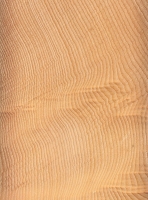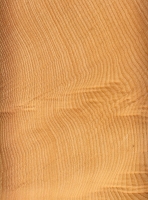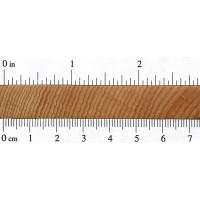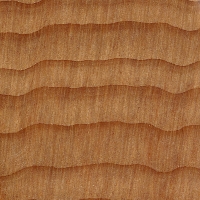 |
Common Name(s): Huon Pine Scientific Name: Lagarostrobos franklinii Distribution: Australia, New Zealand, and southeast Asia Tree Size: 65-100 ft (20-30 m) tall, 2-4 ft (.6-1.2 m) trunk diameter Average Dried Weight: 35 lbs/ft3 (560 kg/m3) Specific Gravity (Basic, 12% MC): .47, .56 Janka Hardness: 920 lbf (4,110 N) Modulus of Rupture: 11,070 lbf/in2 (76.3 MPa) Elastic Modulus: 1,339,000 lbf/in2 (9.23 GPa) Crushing Strength: 6,320 lbf/in2 (43.6 MPa) Shrinkage: Radial: 4.4%, Tangential: 6.1%, Volumetric: 10.9%, T/R Ratio: 1.4 |
Color/Appearance: Varies from light yellow to golden or reddish brown. Darker reddish brown streaks are common in Dacrydium species.
Grain/Texture: Grain is straight or sometimes wavy. Texture is fine and uniform. Moderate natural luster.
Endgrain: Resin canals absent; earlywood to latewood transition moderately abrupt, color contrast medium; tracheid diameter medium-large.
Rot Resistance: Varies depending on species and application. Generally regarded as having good durability in marine applications, though Dacrydium spp. are rated as non-durable in applications of direct ground contact.
Workability: Generally easy to work with both hand and machine tools, though wood with wavy or knotty grain can be slightly problematic. Glues, finishes, and turns well.
Odor: Has a unique resinous odor when being worked.
Allergies/Toxicity: Although severe reactions are quite uncommon, wood in the Dacrydium genus has been reported to cause nose, eye and throat irritation. See the articles Wood Allergies and Toxicity and Wood Dust Safety for more information.
Pricing/Availability: Being that Huon Pine is slow growing, with the trees not reproducing until they are several hundred years old, supplies are limited and expected to only decrease in the future. The wood is occasionally exported; expect prices to be medium to high for an imported softwood.
Sustainability: This wood species is not listed in the CITES Appendices, but Lagarostrobos franklinii is reported by the IUCN as being conservation dependent. Cessation of any current conservation programs would likely result in a vulnerable or endangered Red List status. Dacrydium cupressinum and D. nidulum are both listed by the IUCN as being species of least concern.
Common Uses: Furniture, turned objects, flooring, veneer, and boatbuilding.
Comments: So named because early explorers of Tasmania (then named Van Diemen’s Land) found old tree stumps and logs (still intact) in the Huon River.
Huon Pine was formerly classified as Dacrydium franklinii, but was later moved to its own genus, Lagarostrobos. Rimu is a closely related wood composed of a handful of species still in the Dacrydium genus, primarliy D. cupressinum and D. nidulum. It is sometimes referred to as New Zealand Red Pine.
Like nearly all native pines in the southern hemisphere, Huon Pine is not a true pine, though it is a conifer (softwood). True pines belong to the Pinus genus and grow almost exclusively in the northern hemisphere.
None available.
None available.
 |
 |
 |
 |





Thank you for responding to my enquiry re Huon Pine. This wooden disc also belonged to my parents (I forgot I had it at the time of posting my enquiry) which would also have been sent to them from family in Australia. Could someone identify this wood please?
Could be many species incl. eucalypts and acacias (Ironwood?)
Sand it!
Hi I could you tell me if this is huon pine
If it has really tight rings than it could be.
but I’ve also never seen it crack.
the oils in the wood pretty much make it last for hundreds of years with out showing signs of drying and cracking.
Probably a fast grown soft piece of huon pine, long dead with typical(!) weathering cracks.
I found these two items belonging to my late father. Is this wooden disc made from Huon Pine?
Nope. It appears to be a slice of banksia cone.
It doesn’t look like it’s the wood of the tree but could be a seed pod of one.
Regarding rot resistance, it’s perhaps the most rot resistant tree on the planet. There are trees lying in-tact on the rainforest floor, which fell tens of thousands of years ago. Because of it’s unique rot-resistant oiliness, it was regarded as the premium timber for ship building once it was discovered, back in the age of sail. For this reason, a huge industry came about to extract trees from up the major rivers on the west coast of Tasmania and ship-building itself also became a major industry for the colony. Even working entirely with hand-saws, in remote areas, with no power… Read more »
Re Susan’s question if the timber is fairly light and of old Tasmanian origin it could still be imported Western Red Cedar (NW USA or Canada) exported to Australia including Tasmania since the early 1800’s or possiblyTasmanian King Willian Pine which can have a similar appearance & properties.
Tasmanian Celery Top Pine can appear similar to Douglas Fir with similar properties, but not quite as strong, heavier and more durable
It definitely looks nothing like Huon Pine
Not King Billy.
Hi! I was wondering if you think this is Huon Pine? They are old French doors from Sydney with old Tasmanian Jacksons locks? Thanks
From the grain it does not look like Huon pine
The Huon pine Lagarostrobos franklinii is a conifer
and is endemic to Tasmania. It is the only member
of the genus Lagarostrobos. Related species from the
family Podocarpaceae, originating from the ancient
supercontinent Gondwana, are found in Chile, Malaysia
and New Zealand.
I.E. TASMANIA ONLY – definitely not SE Asia or NZ!
I’ve varnished a boat cabin top made out of strips of Huon pine. 12 months on I’m getting variable sized spots like freckles appearing all over it. Any ideas what might cause this. Not a good look and I don’t have a clue what it is. Look and enlarge the pics and you will see spots appearing all over.
I know nothing, but the pine sounds far too resistant to be at fault. However, it’s oiliness may be interacting with your varnish …
There’s only one species of Huon Pine, which is the sole member of its genus. It’s found only in Tasmania, nowhere else in Australia, and certainly not in New Zealand or South East Asia.
Huon Pine is a great turning wood…easy to work, holds detail and polishes nicely.
Thanks for a great and fast information web-site about wood.
I wood work in many different types of wood & often find myself on
your web-site.I have worked with New Zealand Rimu on a couple of
occasions…The wood is a joy to work with,it does however need plenty
of time to rest before finishing.
That’s a beautiful drum! I should check this stuff out.
Hi,
Thanks for a great and fast information web-site about wood.
I wood work in many different types of wood & often find myself on your web-site.I have worked with New Zealand Rimu on a couple of occasions…The wood is a joy to work with,it does however need plenty of time to rest before finishing.
best rgards
matt